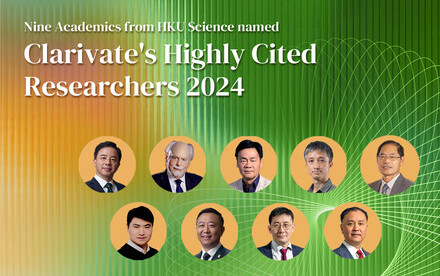05 Jan 2023
Physicists develop a new method that strengthens electron-triggered light emission with flat bands Shedding light to produce new sources of light and build quantum-based computational and communications systems

The artistic illustration above is the interaction between free electrons and flat bands of a photonic crystal slab. Image courtesy: Lei CHEN.
The way electrons interact with photons of light is a vital part of many modern technologies, from lasers to solar panels to LEDs. But the interaction is inherently a weak one because of a major mismatch in scale: A wavelength of visible light is about 1,000 times larger than an electron, so the way the two things affect each other is limited by that disparity.
Now, researchers at The University of Hong Kong (HKU), MIT and elsewhere say they have come up with an innovative way to make much more robust interactions between photons and electrons possible, in the process producing a hundredfold increase in the emission of light from a phenomenon called Smith-Purcell radiation. The findings have potential ramifications for both commercial applications and fundamental scientific research, although it will require more years of investigation to make it practical.
The findings are just published in Nature, a prestigious multidisciplinary journal, by Dr Yi YANG (Assistant Professor of the Department of Physics at HKU and a former postdoc at MIT), Dr Charles ROQUES-CARMES (Postdoctoral Associate at MIT), Professors Marin SOLJAČIĆ and John JOANNOPOULOS (MIT professors). The research team also included Steven KOOI at MIT’s Institute for Soldier Nanotechnologies, Haoning TANG and Eric MAZUR at Harvard University, Justin BEROZ at MIT, and Ido KAMINER at Technion-Israel Institute of Technology.
In a combination of computer simulations and laboratory experiments, the team found that using a beam of electrons with a specially designed photonic crystal — a slab of silicon on an insulator, etched with an array of nanometer-scale holes — they theoretically predicted stronger emission by many orders of magnitude than would ordinarily be possible in conventional Smith-Purcell radiation and experimentally recorded a 100 times increase in radiation in their proof-of-concept measurements.
Unlike other approaches to producing sources of light or other electromagnetic radiation, the free-electron-based method is fully tunable — it can produce emissions of any desired wavelength, simply by adjusting the size of the photonic structure and the speed of the electrons. This may make it especially valuable for making emission sources at wavelengths that are difficult to produce efficiently, including terahertz waves, ultraviolet light, and X-rays.
The team has demonstrated the hundredfold enhancement in emission using a repurposed electron microscope to function as an electron beam source. But they say that the basic principle involved could potentially enable far greater enhancements using devices specifically adapted for this function.
The approach is based on a concept called ‘flatbands’, which have been widely explored in recent years for condensed matter physics and photonics but have never been applied to affect the essential interaction of photons and free electrons. The underlying principle involves the transfer of momentum from the electron to a group of photons or vice versa. Whereas conventional light-electron interactions rely on a single mode of light, the photonic crystal is tuned to enable the production of a whole range of modes at the same frequency at once.
The exact process could also be used in the opposite direction, using resonant light waves to propel electrons, increasing their velocity in a way that could potentially be harnessed to build miniaturized particle accelerators on a chip. These might ultimately be able to perform some functions that currently require giant underground tunnels, such as the 30-kilometer-wide Large Hadron Collider in Switzerland. ‘If you could actually build electron accelerators on a chip,’ Soljačić says, ‘you could make much more compact accelerators for some of the applications of interest, which would still produce very energetic electrons. That obviously would be huge, for example, for radiotherapy. For many applications, you wouldn’t have to build these huge facilities.’
The system could also be used to generate multiple entangled photons, a quantum effect that could be useful in creating quantum-based computational and communications systems, the researchers say. ‘You can use electrons to couple many photons together, which is a considerably hard problem if using a purely optical approach,’ says Yang. ‘That is one of the exciting future directions of our work.’
Much work remains to translate these new findings into practical devices. It may take some years to develop the necessary interfaces between the optical and electronic components and how to connect them on a single chip, and to develop the necessary on-chip electron source producing a continuous wavefront, among other challenges.
‘This is exciting,’ Roques-Carmes adds, ‘because this is quite a different type of source.’ While most technologies for generating light are restricted to very specific ranges of color or wavelength, and ‘it’s usually difficult to move that emission frequency. Here it’s completely tunable. Simply by changing the velocity of the electrons, you can change the emission frequency. That excites us about the potential of these sources. Because they’re different, they offer new types of opportunities.’
In order for the research outputs become truly competitive with other types of sources, it will require some more years of research. With some serious effort in two to five years, they might start competing in at least some areas of radiation.
This article was adapted from the press release of MIT News Office.
More details can be found in the article ‘Photonic flatband resonances for free-electron radiation’.






